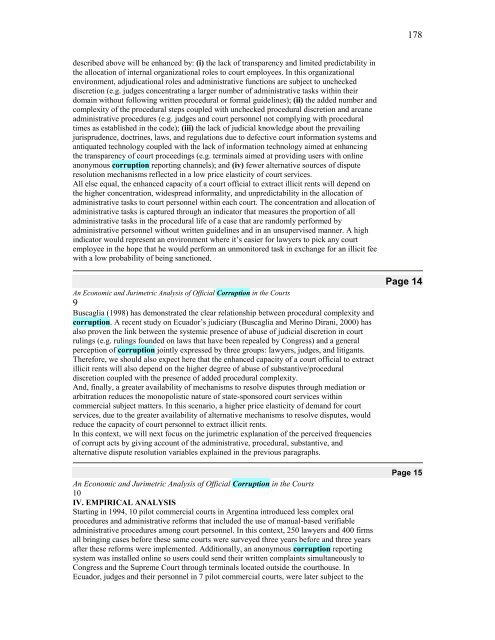FILSAFAT KORUPSI - Direktori File UPI
FILSAFAT KORUPSI - Direktori File UPI
FILSAFAT KORUPSI - Direktori File UPI
Create successful ePaper yourself
Turn your PDF publications into a flip-book with our unique Google optimized e-Paper software.
described above will be enhanced by: (i) the lack of transparency and limited predictability in<br />
the allocation of internal organizational roles to court employees. In this organizational<br />
environment, adjudicational roles and administrative functions are subject to unchecked<br />
discretion (e.g. judges concentrating a larger number of administrative tasks within their<br />
domain without following written procedural or formal guidelines); (ii) the added number and<br />
complexity of the procedural steps coupled with unchecked procedural discretion and arcane<br />
administrative procedures (e.g. judges and court personnel not complying with procedural<br />
times as established in the code); (iii) the lack of judicial knowledge about the prevailing<br />
jurisprudence, doctrines, laws, and regulations due to defective court information systems and<br />
antiquated technology coupled with the lack of information technology aimed at enhancing<br />
the transparency of court proceedings (e.g. terminals aimed at providing users with online<br />
anonymous corruption reporting channels); and (iv) fewer alternative sources of dispute<br />
resolution mechanisms reflected in a low price elasticity of court services.<br />
All else equal, the enhanced capacity of a court official to extract illicit rents will depend on<br />
the higher concentration, widespread informality, and unpredictability in the allocation of<br />
administrative tasks to court personnel within each court. The concentration and allocation of<br />
administrative tasks is captured through an indicator that measures the proportion of all<br />
administrative tasks in the procedural life of a case that are randomly performed by<br />
administrative personnel without written guidelines and in an unsupervised manner. A high<br />
indicator would represent an environment where it‟s easier for lawyers to pick any court<br />
employee in the hope that he would perform an unmonitored task in exchange for an illicit fee<br />
with a low probability of being sanctioned.<br />
An Economic and Jurimetric Analysis of Official Corruption in the Courts<br />
9<br />
Buscaglia (1998) has demonstrated the clear relationship between procedural complexity and<br />
corruption. A recent study on Ecuador‟s judiciary (Buscaglia and Merino Dirani, 2000) has<br />
also proven the link between the systemic presence of abuse of judicial discretion in court<br />
rulings (e.g. rulings founded on laws that have been repealed by Congress) and a general<br />
perception of corruption jointly expressed by three groups: lawyers, judges, and litigants.<br />
Therefore, we should also expect here that the enhanced capacity of a court official to extract<br />
illicit rents will also depend on the higher degree of abuse of substantive/procedural<br />
discretion coupled with the presence of added procedural complexity.<br />
And, finally, a greater availability of mechanisms to resolve disputes through mediation or<br />
arbitration reduces the monopolistic nature of state-sponsored court services within<br />
commercial subject matters. In this scenario, a higher price elasticity of demand for court<br />
services, due to the greater availability of alternative mechanisms to resolve disputes, would<br />
reduce the capacity of court personnel to extract illicit rents.<br />
In this context, we will next focus on the jurimetric explanation of the perceived frequencies<br />
of corrupt acts by giving account of the administrative, procedural, substantive, and<br />
alternative dispute resolution variables explained in the previous paragraphs.<br />
An Economic and Jurimetric Analysis of Official Corruption in the Courts<br />
10<br />
IV. EMPIRICAL ANALYSIS<br />
Starting in 1994, 10 pilot commercial courts in Argentina introduced less complex oral<br />
procedures and administrative reforms that included the use of manual-based verifiable<br />
administrative procedures among court personnel. In this context, 250 lawyers and 400 firms<br />
all bringing cases before these same courts were surveyed three years before and three years<br />
after these reforms were implemented. Additionally, an anonymous corruption reporting<br />
system was installed online so users could send their written complaints simultaneously to<br />
Congress and the Supreme Court through terminals located outside the courthouse. In<br />
Ecuador, judges and their personnel in 7 pilot commercial courts, were later subject to the<br />
178<br />
Page 14<br />
Page 15

















